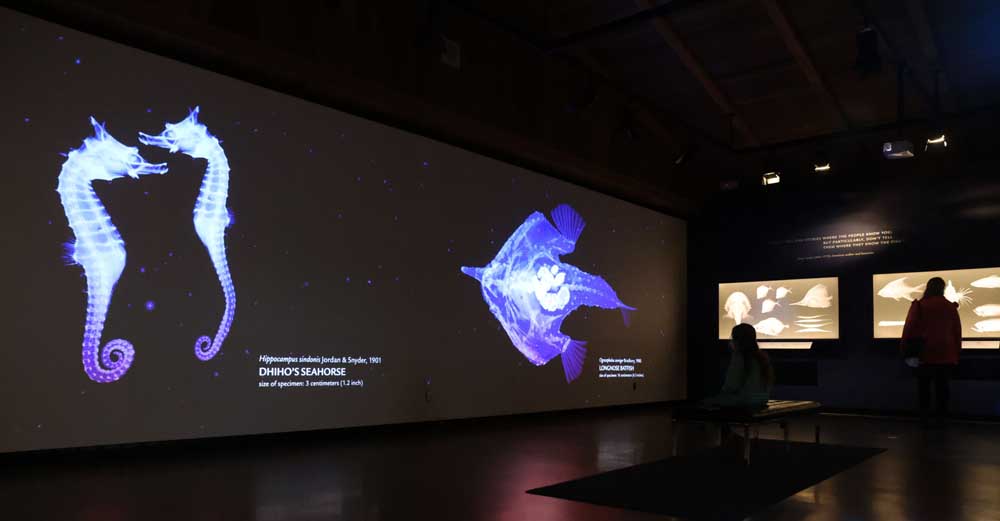Central Oregon venues and event companies get extra help from grants
Published 4:00 am Sunday, October 31, 2021

- Museum patrons experience X-Ray Vision: Fish Inside Out, an exhibition from the Smithsonian’s National Museum of Natural History and Smithsonian Institution Traveling Exhibition Service at the High Desert Museum on Tuesday.
Central Oregon venues, theaters and promoters have received more than $6 million in additional government funding to compensate for losses racked up during pandemic-related closures.
Trending
The funds issued by the Small Business Administration are granted to eligible venue operators, promoters, theatrical producers, live performing arts organizations, museum operators, movie theaters and talent agencies.
These same organizations also were able to receive aid from the federal Payroll Protection Program, according to the SBA. Funds could be used to cover payroll, rent, utilities, debt payments, worker protection costs, administrative costs, insurance and taxes. Initial applications were filed in August.
The funds were important to keep the workers employed and the venues from folding, leaving Central Oregon without entertainment and art. Nationwide, more than $16 billion in federal emergency relief was available to venues, of which $11.6 billion has been awarded to nearly 13,000 venues, promoters and operators nationwide, according to the data.
Trending
Oregon venues received $172.3 million as of Oct. 25, according to the SBA data.
Keeping theaters afloat
The Oregon Shakespeare Festival Association in Ashland received $10 million, as did the Oregon Zoo in Portland. The smallest award in Oregon was for $1,439 for a talent representative in Stayton.
Lay it Out Events, which received the most amount of money in Central Oregon, declined to comment for this story. The Tower Theatre received $862,839, which was the third highest amount of Shuttered Venue Operators Grants in Central Oregon and was used to recall furloughed staff.
“This is the longest challenge we’ve experienced,” said Ray Solley, Tower Theatre Foundation executive director. “I know we’re not alone. It was different than the recession, when discretionary income dried up. This time we couldn’t open and stayed dark until it was safe and people had money to spend.”
It was a similar experience managing the Les Schwab Amplitheater during the closures related to the pandemic. Marney Smith, its general manager, said the last show was Oct. 4, 2019, a 22-month closure that ended Aug. 8. During that time, the amphitheater had no income other than grants, donations and the ability to borrow money, Smith said. But in that time there were many expenses as the staff navigated refunds and cancellations, Smith said.
“Our staff had work to do to help guests navigate getting refunds and credits, canceling other events and sponsorships, communicating with the public, moth-balling the venue and looking toward the future,” Smith said. “The cost of reopening after being shuttered for such an extended period was significant.”
Expenses vs. revenue
While the federal grant did help cover employee salaries and marketing expenses, Smith said, it didn’t cover everything.
For some venues that are nonprofits, it’s a delicate balance of meeting the mission, bringing in revenue and meeting in expenses year -round, said Solley, of the Tower Theatre Foundation. “The business model is a struggle,” Solley said. “Ours is based on 220 events a year, both that we present and those that rent our facility.”
Booking events is something that just doesn’t happen over night, he said. Sometimes acts are booked years in advance. Before the November 2020 election, the Tower Theatre had booked a satirical act with a large following more than three years in advance. The parody act was set to perform two days before the election, he said. But no events were happening then and now the group has disbanded and there’s no way to reschedule the event, he said.
“That was a casualty of the moment,” Solley said. “Now we’re selling tickets and publicizing events two months at a time. The industry is showing a lot of confidence now. We’ll find a way to deal with the protocols in 2022. By 2023 we should be back to the point of scheduling tours and selling tickets in advance and people can make a commitment and all of us will feel secure enough that we’ll be safe.”
And those events are now subject to an industrywide requirements, the result of 19 months of a pandemic. Ticket holders must wear a mask and provide proof of a COVID-19 vaccination, or a negative test result.
Masking up
At the High Desert Museum, on the south side of town on U.S. Highway 97, similar protocols and changes have occurred, the result of the pandemic. While the museum is open now, it’s not the same hours as before the pandemic started in Central Oregon in February 2020, said Dana Whitelaw, museum executive director.
Spring is a busy time for the museum and that was the time it was closed due to government-mandated closures to stop the spread of the virus. Attendance revenue accounts for half the museum’s budget, Whitelaw said. But between grants and federal funds, the museum was able to over come some of those losses.
These funds represented lifeboats for organizations that weren’t allowed to open, Whitelaw said. The Shuttered Venue Operators grant was used to support educational programs and exhibits.
“Having that cut off was a big hit,” Whitelaw said. “Oregon has some of the most restrictive guidelines for venues. There were weeks when we could only have six people inside the museum. That was up until May.”
One bright spot was being one of three museums nationwide to receive the National Medal for Museum and Library Services, an award for community service that helped families and communities through community outreach.
Whitelaw, however, conceded that most museums have fared better than performing arts organizations as a whole. Today, the museum is turning its attention to reaching the community beyond physical boundaries of walls. It is creating and providing access to online content. It also has created educational programming for about 20 students of essential workers at La Pine Elementary school and worked with community groups to distribute iPads and internet access to students in need.
“The museum field, in general, will be committed to the virtual learning beyond the museum walls,” Whitelaw said. “It’s been an incredibly challenging time for the museum, with very high highs and very low lows.”
Top five Central Oregon venues that received Shuttered Venue Operator Grants:
$1.12 million; Lay it Out Inc., live performing arts organization
$880,684; High Desert Museum, museum operator
$862,839; Tower Theatre Foundation, live venue operator
$359,402; Sisters Folk Festival Inc., live performing arts organization
$336,569; Quoin Media & Entertainment LLC, a Sisters motion picture theater operator
Source: Small Business Administration
“The business model is a struggle. Ours is based on 220 events a year, both that we present and those that rent our facility.”
Ray Solley, Tower Theater Foundation








